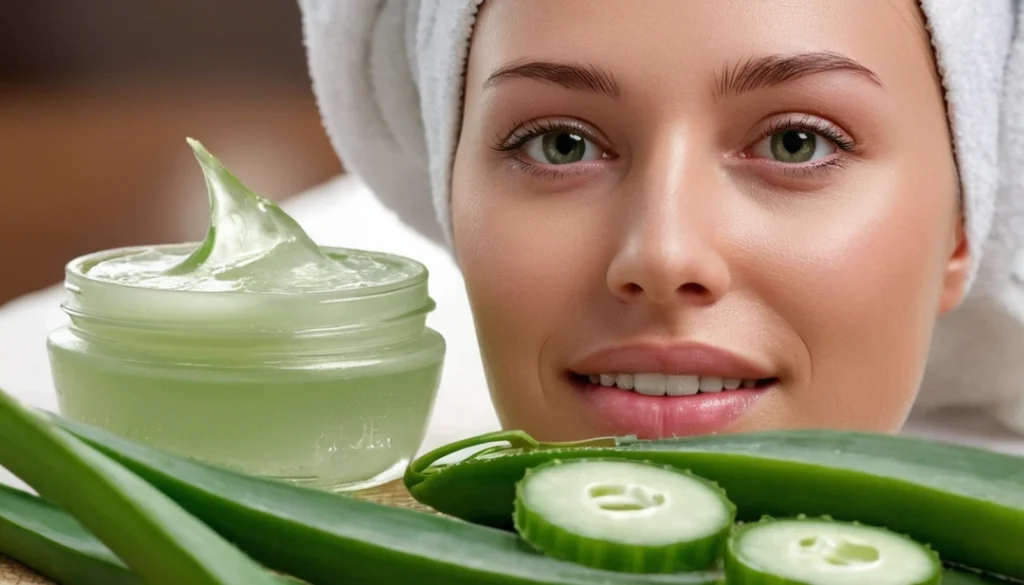
Benefits of Aloe Vera: Nature's Soothing Succulent
Aloe vera is an ancient succulent plant that has been used medicinally for millennia. With its gel filled leaves full of active compounds, this plant can soothe burns, treat skin conditions, support immune health, and more. Read on to discover why aloe vera is called the “miracle plant.”
What is Aloe Vera?
Aloe vera, often referred to as just aloe, is a short stemmed shrubby succulent plant that grows up to 2 to 3 feet tall. It originated in tropical regions of Africa, Asia, and Europe and is now grown worldwide.
The leaves of the aloe plant are thick and fleshy, reaching 12-19 inches in length when fully grown. Inside the leaves is a clear gel that contains over 75 active compounds including:
- Vitamins: A, B12, C and E
- Minerals: Zinc, calcium, magnesium, copper, chromium and selenium
- Enzymes
- Sugars
- Anthraquinones: Provide analgesic and anti-inflammatory effects
- Fatty acids
- Auxins and gibberellins: Aid in anti-inflammatory and wound healing properties
This multitude of nutrients and compounds is why aloe gel has so many topical and internal health benefits which we’ll explore throughout this article
Top Benefits and Uses of Aloe Vera Gel
With an array of vitamins, minerals, and healing compounds, it’s no wonder aloe vera gel has been called a “miracle plant.” Here are some of the top external and internal uses and health benefits of aloe gel and juice.
- Soothing Burns, Wounds and Skin Irritation
- Moisturizing and Anti-Aging Effects on Skin
- Supports Digestive Health
- Boosts Immune Function
- Regulates Blood Sugar Levels

Soothing Burns, Wounds and Skin Irritation
Using aloe topically has long been the primary benefit of the plant. The gel contains two hormones: Auxin and gibberellin which provide anti-inflammatory and wound healing properties. Applying aloe to burns and abrasions helps soothe inflammation and pain while speeding up skin regeneration.
The antibacterial and antifungal aspects of aloe vera also prevent infections in damaged skin and wounds. Plus, the moisture within the gel creates a protective barrier allowing skin to retain moisture and recover faster.
Moisturizing and Anti-Aging Effects on Skin
In addition to healing wounds, regularly applying aloe vera gel hydrates facial skin leaving it less dry, supple, and glowing. The skin readily absorbs aloe due to its 97% water content. It also delivers key amino acids to strengthen the skin’s protein building blocks.
With powerful antioxidants like vitamins C and E, aloe gel neutralizes skin-damaging free radicals to minimize fine lines and wrinkles. Its anti-inflammatory properties also calm redness and irritation in conditions like acne, eczema, and rosacea. like acne, eczema, and rosacea. With regular use, skin becomes smoother, firmer and more youthful-looking.
How To Make Aloe Vera Moisturizer
Ingredients:
Aloe Vera Gel (2 tablespoons) – Soothes, hydrates, and heals the skin.
Coconut Oil or Shea Butter (1 tablespoon) – Deeply moisturizes and locks in hydration.
Jojoba Oil or Sweet Almond Oil (1 tablespoon) – Lightweight oils that mimic the skin’s natural sebum.
Essential Oils (optional, 5-10 drops) – Add for fragrance and additional benefits (e.g., lavender for calming, tea tree for acne-prone skin).
Vitamin E Oil (optional, 1-2 drops) – Acts as a natural preservative and boosts skin repair.
Instructions:
Prepare the Aloe Vera Gel:
If using fresh aloe vera, cut a leaf from the plant, slice it open, and scoop out the gel. Blend the gel until smooth.
If using store-bought gel, ensure it’s 100% pure and free of additives.
Melt the Coconut Oil or Shea Butter:
Gently melt the coconut oil or shea butter in a double boiler or microwave. Let it cool slightly.
Mix the Ingredients:
In a small bowl, combine the aloe vera gel, melted coconut oil or shea butter, and jojoba or sweet almond oil.
Add a few drops of your chosen essential oil (if using) and vitamin E oil.
Blend Thoroughly:
Use a hand mixer or whisk to blend the ingredients until smooth and creamy.
Store the Moisturizer:
Transfer the mixture to a clean, airtight container (preferably glass).
Store in a cool, dry place or in the refrigerator to extend its shelf life.
How to Use:
Apply a small amount to clean skin, massaging gently in circular motions.
Use daily in your skincare routine, preferably after cleansing and toning.
Top Aloe Vera Producing Countries
| Country | Annual Production (Metric Tons) | Major Growing Regions | Primary Varieties |
|---|---|---|---|
| Mexico | 165,000 | Tamaulipas, Yucatan, Jalisco | Aloe barbadensis miller |
| Dominican Republic | 125,000 | La Altagracia, Monte Plata | Aloe barbadensis miller |
| India | 110,000 | Rajasthan, Gujarat, Tamil Nadu | Aloe barbadensis, Aloe vera indica |
| Thailand | 95,000 | Nakhon Ratchasima, Prachin Buri | Aloe barbadensis miller |
| China | 85,000 | Hainan, Guangdong, Yunnan | Aloe vera chinensis |
| United States | 75,000 | Texas, California, Florida | Aloe barbadensis miller |
| Costa Rica | 65,000 | Guanacaste, Alajuela | Aloe barbadensis miller |
| Venezuela | 55,000 | Falcón, Lara | Aloe barbadensis miller |
Supports Digestive Health
Internally, aloe vera juice contains compounds known as anthraquinones that provide potent laxative effects. Drinking just 2-4 ounces can help ease constipation and promote regularity.
Additionally, aloe vera coat and soothe gastrointestinal inflammation making it an effective remedy for inflammatory bowel diseases like ulcerative colitis. Its enzymes even aid in digestion by breaking down sugars and fats.
Boosts Immune Function
Aloe leaves contain special polysaccharides along with antioxidants like vitamin C and E, which stimulate the immune system to fight bacterial and viral infections. Sipping just a couple of ounces each day may ward off everything from the common cold to more serious conditions.
Regulates Blood Sugar Levels

Early evidence suggests aloe vera may enhance insulin sensitivity and help normalize blood sugar in those with type 2 diabetes and prediabetes. When taken for several weeks, aloe vera capsules have been shown to lower A1C levels by as much as 1.5 points.
Other Aloe Vera Benefits
- Alleviate heartburn and GERD
- Reduce cavities and gingivitis
- Lower cholesterol and triglycerides
- Treat osteoarthritis when taken orally
- Prevent kidney stones
- Provide anti-cancer properties.
Alleviate Heartburn and GERD
Preliminary studies indicate that drinking aloe vera juice may coat and protect the esophagus and stomach lining to calm heartburn and acid reflux symptoms. It may soothe ulcers as well with powerful anti-inflammatory effects.
Reduce Cavities and Gingivitis
Test tube studies reveal aloe vera gel battles cavity-promoting Streptococcus and Lactobacillus bacteria in the mouth. When made into a tooth gel, aloe’s antibacterial actions may reduce dental plaque and gingivitis especially when combined with proper brushing.
Lower Cholesterol and Triglycerides
Animal research discovered that mice fed aloe vera juice had decreases in LDL and total blood cholesterol as well as liver and intestinal triglyceride levels showing promise for managing high blood lipids. Human trials are still needed however.
Treat Osteoarthritis When Taken Orally
Early lab research indicates oral doses of aloe may inhibit inflammatory compounds linked to painful osteoarthritis and rheumatoid arthritis in affected joints, providing hope it may complement other conventional treatments to ease swelling and enhance mobility.
Prevent Kidney Stones
The powerful laxative effects and urine stimulation from compounds in ingested aloe latex could potentially help decrease kidney stone risk by keeping waste flowing smoothly through and out of the kidneys. Further studies are underway.
Provide Anti-Cancer Properties
Test tube investigations suggest aloe’s antioxidant anthraquinones induce cell apoptosis and block tumor formation, showing possible anti-tumor benefits. More evidence is required to verify effects in humans however.
As you can see, aloe vera boasts an astounding range of topical and internal perks. And these are just the main, scientifically-studied benefits.
Growing and Caring for Aloe Plants
While it’s simple and affordable to buy bottled aloe vera gel and juice, you can also grow this succulent yourself year round whether in pots or beds outdoors. Here is everything you need to know about caring for aloe plants.
- Light Conditions
- Soil Needs
- Water Requirements
- Propagating Aloe
- Repotting
- Outdoor Care
Light Conditions
Aloe thrives best in full, direct sunlight for several hours per day which leads to optimal growth and the highest concentration of healing compounds in the leaves. Provide at least 4 to 6 hours of sunlight if kept indoors.
Soil Needs
Use fast-draining cactus/succulent soil mix and allow it to fully dry between waterings. Add perlite or small stones to improve drainage if needed.
Water Requirements
Overwatering leads to root rot so only water when the top several inches become completely dry. Wait even longer in winter when growth slows.
Propagating Aloe
Mature plants produce pups or offshoots which can simply be removed and repotted to easily make new plants.
Repotting
Repot in the spring every 2-3 years in containers just a bit larger than the root mass. This prevents rootbound plants.
Outdoor Care
In temperate climates, aloe can be grown outside provided they are kept above 40° F in winter. Bury pots to insulate roots.
By following these simple care guidelines, your aloe vera plants will produce abundant healing leaves for years to come. Now let’s look at properly harvesting and preparing the gel.
Worldwide Aloe Vera Production Trends (2014-2023)
| Year | Mexico | Dominican Republic | India | Thailand | China |
|---|---|---|---|---|---|
| 2023 | 165,000 | 125,000 | 110,000 | 95,000 | 85,000 |
| 2022 | 162,000 | 122,000 | 108,000 | 92,000 | 83,000 |
| 2021 | 158,000 | 120,000 | 105,000 | 90,000 | 80,000 |
| 2020 | 155,000 | 118,000 | 102,000 | 88,000 | 78,000 |
| 2019 | 152,000 | 115,000 | 98,000 | 85,000 | 75,000 |
| 2018 | 148,000 | 112,000 | 95,000 | 82,000 | 72,000 |
| 2017 | 145,000 | 108,000 | 92,000 | 80,000 | 70,000 |
| 2016 | 142,000 | 105,000 | 88,000 | 78,000 | 68,000 |
| 2015 | 138,000 | 102,000 | 85,000 | 75,000 | 65,000 |
| 2014 | 135,000 | 98,000 | 82,000 | 72,000 | 62,000 |
Harvesting, Preparing and Using Aloe Vera Gel
When several lower leaves on a mature plant reach full size of around 8-12 inches long, they can be removed for use:
Harvesting Leaves
- Carefully select leaves to cut using a sharp, sterilized knife.
- Try not to damage other leaves during removal.
- Cut as close to the base as possible.
Fillet Out Gel
- First slice off the thorny edges.
- Make a vertical incision down the side to open up the leaf.
- Use the knife to gently separate the clear inner gel fillet from the green rind.
- Scrape off any leftover residue from the sides.
Once harvested and filleted, there are countless ways to use aloe gel:
For Skin, Hair and Nails
- Apply directly onto burns and irritated areas
- Whip into moisturizing DIY lotions, creams, masks and shampoos
- Mix with coconut oil and use as a skin and nail treatment
For Drinking
- Blend into smoothies, juices and health shakes
- Mix with water or other fruit juices
- Freeze into popsicles for a refreshing summer snack
When ingesting aloe, it’s vital to understand proper dosing to avoid unwanted side effects.
Aloe Vera Dosage and Side Effects
Used topically, pure aloe gel is generally considered very safe with little risk of side effects. Oral intake of the latex found just under the plant’s skin however does pose some possible adverse reactions.
Topical Gel Dosage
When applying directly onto skin, burns or hair, you can use aloe gel as needed without restrictions. Always test a small area first to check for potential allergic reactions.
Oral Juice/Supplement Dosage
According to research, the recommended oral dose of aloe latex or gel is:
- Constipation: 50 mg per day
- Ulcerative colitis: 100 milliliters twice daily
- Diabetes: 1 tablespoon twice per day for 4-8 weeks
- Gel capsules: As directed, usually 200-400mg 1-3x daily
Drinking up to 8 ounces of juice per day is considered safe for adults when aloe latex is removed during processing. Limit intake to 1-2 ounces daily for children ages 12 and under.
Who Should Not Take Aloe Internally
When taken appropriately, aloe gel and latex are considered safe. However, consuming high amounts may lead to abdominal pain, diarrhea or cramping from the laxative actions.
Here are some of the possible side effects of ingesting too much aloe vera:
- Diarrhea
- Cramping
- Low potassium levels (hypokalemia)
- Muscle weakness
- Urine discoloration
- Constipation once laxative effects wear off
Signs you may have overdosed on oral aloe include severe diarrhea, intense stomach pain, vomiting, tremors or cold extremities. Discontinue use and see a doctor if these occur.
Interactions with certain medications are also possible when taking aloe latex internally including:
- Diuretics
- Laxatives
- Blood sugar medications
- Digoxin
- Certain blood thinners and supplements
Always talk with your doctor before drinking aloe juice regularly, especially if you take any prescription or over-the-counter medicines as effects may be amplified.
For these reasons, pregnant and nursing women as well as young children should not ingest aloe vera products at all due to increased risk.
The compound responsible for many of aloe’s benefits but also its side effects is a latex substance called aloin. When buying bottled juices and supplements, choose brands labeled as “decolorized” which means aloin has been removed to make them safer if consuming orally.
The Takeaway: Why Aloe Vera Deserves a Spot in Your Home
With vitamins, enzymes and minerals plus powerful skin-healing and anti-inflammatory compounds, it’s easy to see why aloe vera has earned the name “the miracle plant” after being used medicinally for over 6,000 years!
From providing burns and wound relief, diminishing acne, rosacea and signs of aging to enhancing digestion, immune support and potentially aiding diabetes management, no other single plant on earth offers this astounding spectrum of topical and internal perks.
While more research is still needed to confirm some effects, the proven benefits of aloe vera for skin health and digestion along with its availability and affordability make it well worth integrating into skincare regimes, keeping as an indoor plant and even drinking regularly.
So the next time you have an angry sunburn, a flaky complexion, the urge to detox your system or simply crave an exotic plant to adorn your living space, reach for aloe vera. Chances are, you’ll discover countless ways this wondrous succulent can help enhance your daily life.
Conclusion:
Add Aloe Vera to Your Self-Care Regimen
With over 75 active compounds including vitamins, enzymes, minerals, and various potent healing agents, it’s clear why aloe vera is regarded as a deeply nourishing plant for both skin and overall wellness.
From providing topical relief for sunburns, acne, dry skin, and wounds to stimulating digestion, gut health, immunity and potentially much more when consumed orally, aloe vera’s benefits span both inner and outer radiance.
Yet what makes this ancient plant so intriguing beyond even its medical capabilities is how pleasing it is to grow in the home thanks to lovely succulent leaves and minimal care needs.
While more research is still emerging on some effects, the proven topical perks plus nutritional rewards you can easily experience yourself make aloe vera a worthy staple.
Consider incorporating aloe into body care regimes to heal and hydrate skin. Grow a few pots to adorn indoor spaces with vibrant greenery.
And don’t be afraid to regularly drink pure, additive-free juices and experiment with supplements to discover firsthand how aloe vera can nurture you from head to toe with an astonishing spectrum of natural plant compounds.
So allow the “miracle plant” to work its magic in your own life. Chances are, you’ll soon be singing aloe vera’s seemingly endless praises too.
Frequently Asked Questions
What gives aloe vera its healing and restorative powers?
Aloe contains over 200 active compounds including antioxidants like vitamins A, C and E, amino acids, enzymes, sugars, lignins and anthraquinones that together reduce inflammation, fight infection, and regenerate skin cells.
What amino acids make aloe so good for skin and wounds?
Key amino acids include lysine and proline to build collagen, alanine to form elastin, plus hydroxyproline and arginine to stabilize proteins and accelerate cell turnover – rapidly restoring skin.
Can I blend and eat aloe vera leaves from my garden?
No, only the clear inner leaf gel is edible. The green rind and outer skin contain a bitter yellow latex that acts as a harsh laxative. Properly fillet leaves to access the inner gel/juice.
What’s the best way to take aloe supplements?
Look for decolorized pills using purified whole-leaf aloe extracts for the most complete vitamin, antioxidant and acemannan polysaccharide concentrations beneficial for digestion.
Does drinking juice provide vitamin C and other aloe nutrients?
Yes! Consuming up to 8 ounces of ready-to-drink aloe beverages gives a light dose of antioxidant vitamin C, wound-healing zinc, plus amino acids and hydrating electrolyte minerals.
References
https://www.webmd.com/diet/supplement-guide-aloe-vera
https://www.medicalnewstoday.com/articles/318591
https://www.mountsinai.org/health-library/herb/aloe
https://www.healthline.com/nutrition/aloe-vera-juice-benefits
https://www.nccih.nih.gov/health/aloe-vera
https://www.news-medical.net/health/Health-Benefits-and-Dangers-of-Aloe-Vera.aspx
Contents
- 1 Benefits of Aloe Vera: Nature's Soothing Succulent
- 1.1 What is Aloe Vera?
- 1.2 Top Benefits and Uses of Aloe Vera Gel
- 1.3 Soothing Burns, Wounds and Skin Irritation
- 1.4 Moisturizing and Anti-Aging Effects on Skin
- 1.5 How To Make Aloe Vera Moisturizer
- 1.6 Top Aloe Vera Producing Countries
- 1.7 Supports Digestive Health
- 1.8 Boosts Immune Function
- 1.9 Regulates Blood Sugar Levels
- 1.10 Growing and Caring for Aloe Plants
- 1.11 Worldwide Aloe Vera Production Trends (2014-2023)
- 1.12 Harvesting, Preparing and Using Aloe Vera Gel
- 1.13 Aloe Vera Dosage and Side Effects
- 1.14 Who Should Not Take Aloe Internally
- 1.15 The Takeaway: Why Aloe Vera Deserves a Spot in Your Home
- 1.16 Conclusion:
- 1.17 Frequently Asked Questions
- 1.18 What gives aloe vera its healing and restorative powers?
- 1.19 What amino acids make aloe so good for skin and wounds?
- 1.20 Can I blend and eat aloe vera leaves from my garden?
- 1.21 What’s the best way to take aloe supplements?
- 1.22 Does drinking juice provide vitamin C and other aloe nutrients?
- 1.23 References

